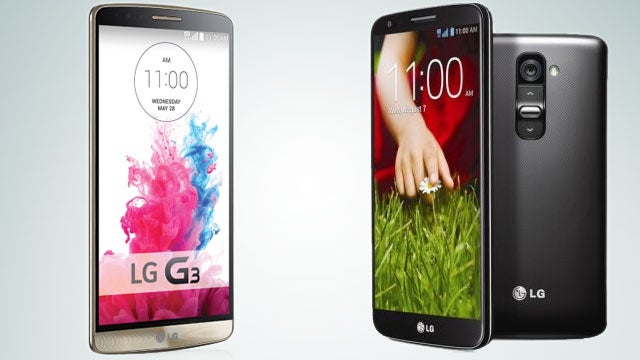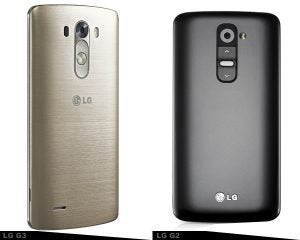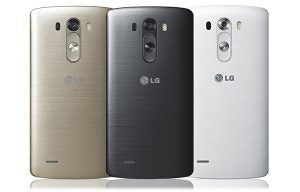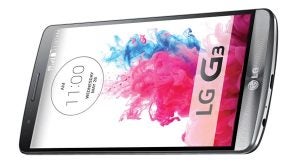LG G3 vs G2 – What is different?

Is LG’s Best a Whole Lot Better?
The LG G3 is the most important phone for LG in 2014. It’s the mobile that’s out to offer an alternative to the biggest phones of the year, including the Galaxy S5 and Xperia Z2.
But is the LG G3 that much of a step forward? Here’s how the new phone compares to its predecessor the LG G2.
The LG G3 has a larger, higher-resolution screen
The LG G3’s most important new feature is its screen. It is the first phone we’ve seen first-hand with a QHD screen, which is the equivalent of four 720p screens stitched together.
This gives the phone a ridiculously high pixel density count of 538ppi, making it far sharper – in theory – than phones like the Galaxy S5.
The LG G2 has a more conventional 1080p resolution screen, although at review we noted that its display is perfectly sharp already.
It seems almost odd to say so, but the most noticeable difference between the LG G3 and G2 screens is about size, not resolution. The LG G3 has a 5.5-inch screen, the LG G2 a 5.2-inch one.
A bigger display will make the LG G3 marginally better for watching films, and should make some games a bit more enjoyable. But they are in the same class screen-size-wise.
SEE ALSO: Galaxy S5 vs LG G3

The LG G3 is a bit bigger
A larger screen all-but necessitates a bigger body, but we’re quite impressed by how little the screen size increase has affected the dimensions.
The LG G3 is 74.6mm wide and 146.3mm tall, up against the LG G2’s 138.5mm tall, 70.9mm wide frame. There’s certainly a significant difference and some of you will find the LG G2 a bit easier to wield. But LG’s super-slim bezel means as little has been added to the footprint as possible.
For evidence of how much larger the LG G3 could have been, we only need to look at the Galaxy Note 2, a 5.5-inch phone. It tried to stay fairly small, but is still 5mm taller and 5mm wider than the LG3.
Both LG phones are 8.9mm thick, which is fairly thin, if not among the slimmest phones around. Check out the Huawei Ascend P7 if you want to meet a genuinely super-thin phone.
SEE ALSO: Android 5.0 release date and rumours

The LG G3 has a metal back cover, and hides a microSD
Stylistically, the biggest difference between the LG G2 and G3 is that where the LG G2 was plastic, the back cover of the LG G3 is faux metal – it’s still plastic, but looks like metal. It’s a slightly bolder look, but one that’s perhaps more fitting for a phone that leads LG’s range of phones.
This time around the back pops off, too. In the LG G2 the back was sealed in place, giving you no access to the battery. In the G3, the back cover hides the microSD memory card slot, something that was absent in the G2. It makes the new phone a good deal more flexible for people who want to use the phone as a music or video player.
The LG G3 is more power-efficient, has same-size battery
The LG G3 doesn’t have a much higher-capacity battery than the phone it effectively replaces. But how can it afford to do this when it has a larger, much higher-resolution screen?
It uses a screen technology pioneered by LG called LTPS. It stands for low temperature polysilicon, and is a screen architecture designed to promote efficiency and to make producing seriously high ppi displays like the LG G3’s easier.
The LG G3 is slightly more powerful, but not much
Both the LG G3 and LG G2 use Snapdragon processors by Qualcomm. The G2 has a Snapdragon 800 chip, the G3 a Snapdragon 801 chip.
As the naming suggests, there’s not a vast difference between the two. The Snapdragon 801 is a turbo charged version of the Snapdragon 800, but each features the same sort of optimisations, the same core structure.
You get four cores. In the LG G3 they’re clocked at 2.5GHz, in the G2 they are also 2.26GHz. However, the max clock speed of the 801 is faster, and the camera’s image signal processor is faster too. The GPU is a bit faster to boot.
However, processor power isn’t the best reason to buy an LG G3 over a G2, and is certainly no reason to buy a G3 if you already have the older model.
SEE ALSO: Snapdragon 805 vs 801 vs 800
The LG3 has laser focusing and a newer camera sensor
The basic specs of the LG G3 camera sound eerily similar to those of the LG G2. They have 13-megapixel sensors, LED flashes and optical image stabilisation.
However, we believe that the LG G3 has a camera sensor that’s a generation on from that of the LG G2.
For a bit more detail, the LG G2 uses a Sony IMX135 sensor – don’t worry, many non-Sony phones use Sony sensors. It is highly likely that the LG G3 uses the newer IMX214 sensor, seen in the Huawei Ascend P7.
The new sensor promises better HDR performance, and better overall image quality.
The LG G3 also has a laser focusing system. A ‘laser pointer’ to the side of the camera lens fires out a laser light beam when you’re snapping in low-light conditions. It gives the phone’s contrast detect focusing system something to hone onto when there’s just not enough natural light to use.
Using a safe Class I laser means the range of this laser won’t be much more than a few metres, but it should come in super-handy regardless. And it means you won’t have to fire off the LED flash whenever it gets dark in order to focus.
LG G3 vs G2: First Impressions
The LG G3 looks like a corker of a phone. It’s a real competitor for the Galaxy S5 and its kin. However, we don’t think the LG G2 is remotely out for the count just yet. While the G3 is better in most respects, it’s not a giant leap forward in that many. If you fancy saving a few quid, the G2 is still worth considering.
Next, read our best Android phones or our Android 4.4 tips, tricks and secrets


